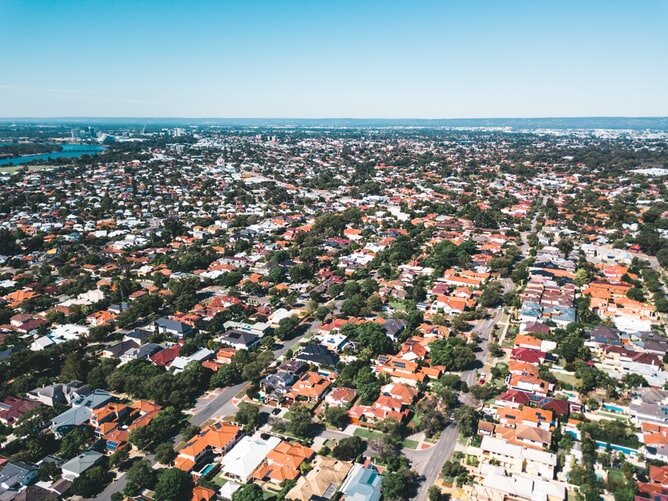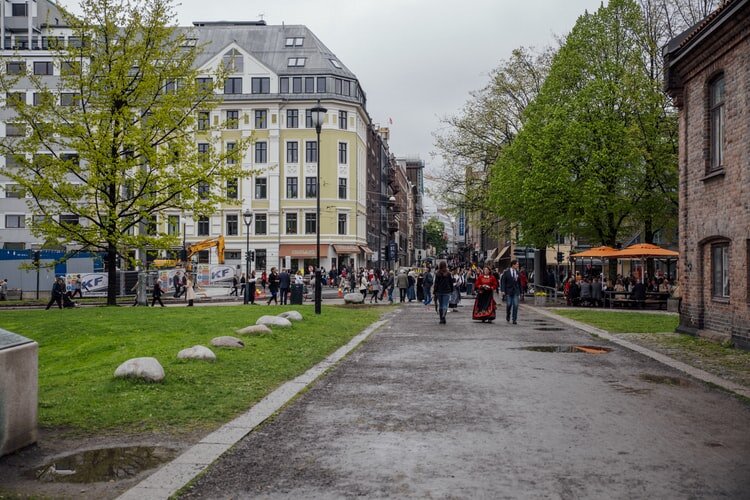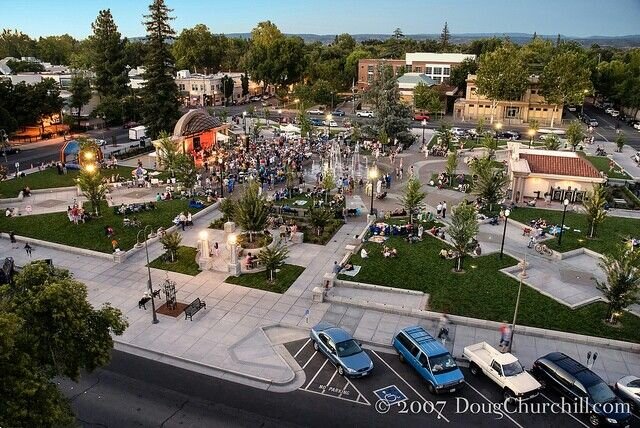7 Reasons We're Thankful for Place this Thanksgiving
Happy Thanksgiving, everyone! This is our FOURTH annual installment of our gratitude post - one of our favorite posts of the year where State of Place team members give thanks to special places - and people - in their lives. We also want to thank YOU all for trusting us to help you unlock the power of data to make it easier (and more cost effective) to plan, deliver, and invest in awesome places people love! We hope to help many more of you in 2020 and we welcome you to SHARE which PLACE you are grateful for below in the comments!! :)
Mariela, here!
My Miami (Florida) - Love It or Leave It
As I write this from Miami while visiting family on a pre-thanksgiving trip, I can’t help but think of how much this place shaped by perspective of place. Nearly every talk I give starts with one of my Miami memories – emphasizing just how starkly different those are than most people’s impressions of or experiences in Miami. For me, as I say, my Miami, the real Miami, was less palm-tree lined paradise and more strip mall lined purgatory; less bikini-clad and more car-congested; less glitzy and glamorous and more Anytown USA (just slightly more Latinized). But not for the experience of growing up in a car-dominated, place-challenged city, I likely would not have dedicated the last 20+ years to using data and evidence to advocate for better places (Miami Cubans are stubborn, so I couldn’t just merely tell them place mattered!). So today, on this Thanksgiving week, I give thanks to the city that fueled (pun mostly intended) my unapologetically Cubanized (i.e., loud, unrelenting, and genuine) passion for place. And I give thanks that I get to share that Latina passion with dozens of places around the globe every year, which this year included London, Miami, Charlotte, Stockholm, Ålesund, New York, Tel Aviv, Oslo, Boston, Chattanooga, Rotterdam, and soon Basel, giving keynotes, lectures, plenaries, and workshops on how to use data to make better places - and make your life easier while doing so! I would SO love to come share this passion with you in your city next year and show you how you can use data (and a bit of stubborn passion) to transform your place into something for which you can indeed be thankful! You can find out more how to bring me to a city near you here! Of course, we are particularly grateful to the 30+ cities and developers we’ve welcomed into the State of Place family so far we home to be fortunate enough to welcome you into the fam in 2020 and beyond! (You can find out more via a live demo and get a free block of your choice to test it out as our thanks to you!)
From Michelle, our COO:
From the Detroit Burbs to Sunny, “Walkable” San Diego
Five months ago, I moved from the Detroit metro region to San Diego and I am so grateful for my new home and community! I grew up in California, went to school at UC Irvine (with Mariela!), and worked in the region for many years afterward, including at the City of Irvine itself, one of State of Place’s customers, as it were. But I had been away for over a decade. I can’t tell you how much more I now appreciate consistently sunny weather, virtually year round. Last week, I took my kids to the beach at La Jolla Shores and we enjoyed a hot November day swimming and playing in the sand. Meanwhile, the midwest was being pounded by a winter storm. I’m so thankful to be living in a place with incredible natural beauty as well as quality educational institutions, parks, dining, entertainment, museums, and much more. It’s also so refreshing to be living in a city that has been thinking about - and investing in - walkability and place for the past couple of decades. It was decidedly much easier to find a home in a walkable neighborhood, and that has made an incredible difference in my day to day life. As a parent, I was particularly excited that our home is within walking distance to the elementary school and a recreation center! But…after a week of walking to school, we realized that while distance to the school is not an issue, design definitely is. It’s clear that while the bones are there (in State of Place speak, we have good form, density, and connectivity - or a good baseline urban fabric), our neighborhood is not a people-first place, and instead prioritizes the needs of cars over pedestrians - especially vulnerable pedestrians like children. It is in serious need of a facelift to make it safer to walk and bike to and from school among other trips that would otherwise be conveniently and comfortably be done on foot. Thankfully, I am the COO of a startup that helps communities use data to do just this! So, although this is a challenge at the moment, it’s a great opportunity for a grass-roots, data-driven, demonstration project! Stay tuned!…
From Andy, our CTO:
Train Life…and Historic Walkable Places
In the past couple of months, I’ve had the privilege of visiting several North American cities, including Vancouver, Seattle, and San Francisco and more recently New York, New Orleans, Nashville, Jacksonville; and I will be in Raleigh-Durham over Thanksgiving. I’m first grateful for the remaining fragments of our once great passenger rail system, which still makes it possible to travel comfortably (with sleeper cars!) and reduce my “flygskam” (shame of flying) a bit. I’m also grateful for the rich parts of American arts culture that are flourishing, such as our music, theater, and dance, despite the continued deterioration of America’s built-form, economic equality, and public funding of arts and science, all of which most hurts the people busy making this country so genuine. I now live in Europe in Oslo, one of the most forward thinking places in terms of urban planning, sustainability, and equality. I’m grateful that State of Place is letting me take cues from Europe–a Europe that prospered in part because of American generosity–to help guide America back toward healthy urban development (although Europe needs a lot of help too!) I don’t have to read about American politics to feel sad these days…I just have to experience the polluting freeways, the obesity, and loneliness, and now the monstrous rise in California homelessness to know that the country is in desperate times. But at State of Place, we’ve developed tools to help cities and developers prioritize urban design changes that will most effectively address these problems, while getting buy-in from people of all different ideologies by showing how these changes can lead to prosperity for their cities and towns. In other words, we’re using data and evidence to actually help cities and developers quickly execute their visions to create better places, while ensuring they’re maximizing the bang for the buck — this runs counter to the idea of pushing new tech or shiny gizmos for tech’s sake, which often do a lot for tech companies (hello, the new Tesla truck got 250K orders, essentially giving Musk a $2.5M interest free loan, and I’m not quite sure how that’s going to save the world, but I digress), but not enough for people, places, and those creating and investing in them. I’m grateful to work with a bunch of planning and data geeks that get it, and whose passion is focused on making people and places happier and healthier.
From Kelliann, our Business Development Director:
Movement toward walkability in traditionally car-first places!
I am thankful for how many historically car-first cities I have visited this year (including the city I live in) are starting to “get” place! First, living in Las Vegas gives me immense gratitude for strategically placed, well-designed elevated crosswalks. These can be a win-win for cars and peds (when designed correctly and combined with great placemaking of course!). On The Strip, elevated crosswalks relieve congestion, but most importantly, they save lives. When hundreds of people cross a street at once, 24/7 on repeat, and countless speedy cabs require access to the street as well, I can't say thank you enough for the elevation of the pathway across for walkers. In my home state of Texas, I've been very impressed with the variety of placemaking efforts happening in Houston, in and around the Uptown district (who is of course, one of our customers! Check out the report we generated from our software about the ROI of their streetscape and BRT project here!). Additionally, I'm proud of the mindful leadership focused on smart city techniques in San Antonio. Regionally, here in the Mountain West, I'm thrilled to see Phoenix expanding their incredible rail system. It was a scary moment seeing a ballot initiative threaten to block this expansion and effectively throw away 100 million dollars in federal funding that had already been approved. You read that right! Federal funding for rail. 100 millions dollars toward it. I'm grateful the ballot initiative to block it did not pass — and glad to see leaders like Scott Smith of Valley Metro forging onward with the good work he began! More generally, it's a pleasure seeing urban design improvements that emphasize pedestrian safety in a range of Town Center style developments including the District at Green Valley in Henderson, NV, Sugar Land Town Square southwest of Houston, and Town Square in Las Vegas, to name just a few. The creativity of this movement fascinates me, and I'm grateful for its niche sensitivity to humankind's need and desire to walkabout — and of course, I’m thankful to work for a company that is advancing these efforts using data and evidence so that folks like you have an easier time convincing the powers that be that investing in and creating walkable places is worth it - and of course make sure that you’re focusing on the right urban design features to get the biggest bang for your buck!
Kaustubh, our Visual Machine Learning Specialist
Thanks, Chico! (California)
I am thankful to the old, yet young at heart, city of Chico. A small city in northern California, not known to many, this city has uniquely fused integral parts of American culture with nature. Situated in the middle of Bidwell park, Chico offers the best environment for students, as a quintessentially university town. With Chico State at its heart, there are always different activities going on in all parts of the city (except when holidays or exams are underway, of course). In fact, the City of Chico is a de facto urban campus - which makes it incredibly convenient and accessible. As a graduate of Chico State myself (that’s where I perfected much of the work I’m doing now for State of Place - using visual machine learning to automate our data collection so we can calculate the entire world’s State of Place near instantly!), I am thankful to the people who made my stay in Chico so memorable and still continue to welcome anyone from anywhere around the world no matter their background. After the devastating ‘Camp fire’ in 2018, which wiped out almost the entire Paradise town, Chico houses most of the surviving population and continues to support them actively. After all of this, I am certain that Chico is way more than just a ‘Party town’. Thanks so much, Chico!
Minah, our sales & marketing intern
Evaluating and experience places of all types for all people
I am thankful for having had the opportunity to experience the many ways in which humans have settled “places” - ranging from urban, rural, and even suburban places. I’m particularly grateful for having gained a critical lense from which to assess the strengths and weaknesses of each type of place, especially now working at State of Place! First off, I grew up in the Washington D.C. Metro Area, in major suburban hub that survives off of the beltway and historically, known as one of the top ten regions for traffic jams and pollution. But I’ve been fortunate to see the region evolve into one of the top areas for transforming suburban places into walkable urban hubs, given its commitment and focus to people-first places. It’s no wonder State of Place has its roots in DC, where it first established the relationship between urban design and real estate value. Now, the notably not urban side of my experiences, I currently attend Mount Holyoke College, located in Western Massachusetts, where I have had the opportunity to see the ways in which rural communities thrive and operate. Living near plentiful, relaxing vegetation, I’ve been privileged to experience the benefits of living so close to nature firsthand, and how restorative this can be. It’s no wonder studies have shown that living near “green” spaces can add years to one life! It’s given me much more appreciation for rural communities and has highlighted the importance of thinking more broadly and inclusively when promoting walkability and placemaking. Finally, I have had the privilege to live in Philadelphia, Boston, Berkeley, and London, each for several months at a time, during which time, I have appreciated the fact that walkable, liveable places come in a variety of layouts, histories, atmospheres, cultures, and public services (all of which State of Place understands and accounts for!). These myriad experiences with such wide-ranging places has expanded my perspective on what makes for great cities, and that we cannot promote a one-size-fits-all, top-down theory of how best to create and transform great places. As I grow older, I hope to see more and more of the globe, and use what I learn to make the world a better place!
Tyler, Our Product Development Intern
Gracias, Barcelona
I am thankful for the accessibility and continued preservation of historic European cities. Having studied in Barcelona, Spain this past Spring, I was fortunate to have the opportunity to experience (from a tourist perspective) seven different European cities. These places have a booming tourism industry, so they must artfully incorporate modern luxuries with a preserved historic culture, while still maintaining an efficient urban life for the locals. Barcelona, my home away from home, specifically has a reputation as an urban planning masterpiece. From the narrow alleyways of the gothic quarter, to the bike paths running along the Balearic coastline, to its famous - and quirky - architecture, Barcelona is perhaps one of the most walkable cities out there. And it shows no signs of slowing down: proposed superblocks have been approved, allowing pedestrians and cyclists to enjoy nine square blocks of car-free walkways. So, huge shoutout to Barcelona for giving me the time of my life (and shed pounds from all the walking). I’m excited for its future (and, as a leader in Smart Cities, hope to welcome the Barcelona into the State of Place family, perhaps in 2020)!
Thanks again for striving so hard to plan, deliver, and invest in great walkable, livable places that make people safer, healthier, and happier and are helping to save our planet, one awesome street at a time! If you are spending loads of time pulling together case studies and anecdotal evidence to convince others of the power of place (and struggle to get buy-in and support for your projects) and/or want to use data to uncover opportunities and unlock the most value (across the triple bottom line for your projects), please get in touch!! We want to learn more about your hurdles and figure out the best ways to overcome them together!! The world can’t wait for great places!! We’re here to cut down the time, money, and headaches that come with your hard work - and make those limited dollars go further while at it! :)









